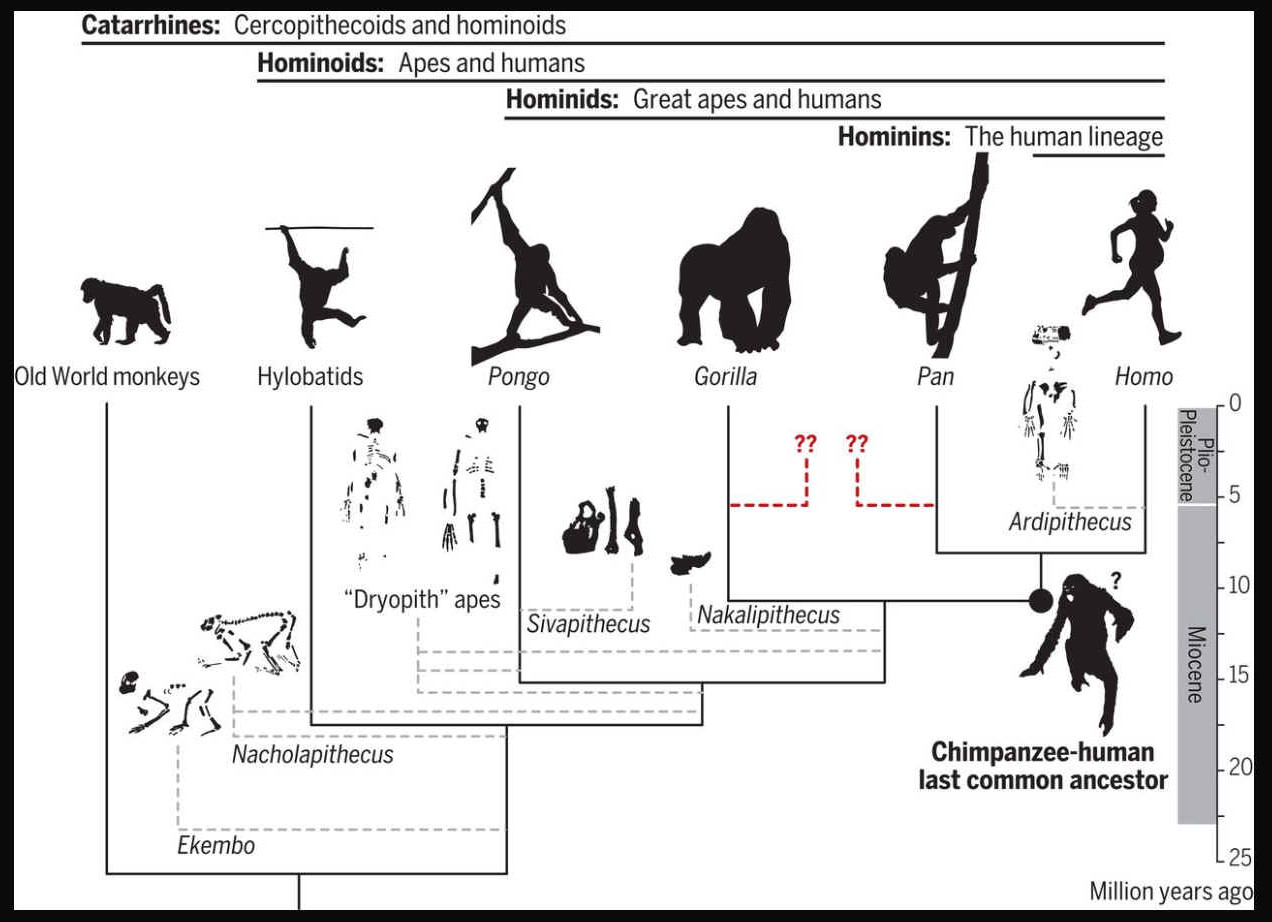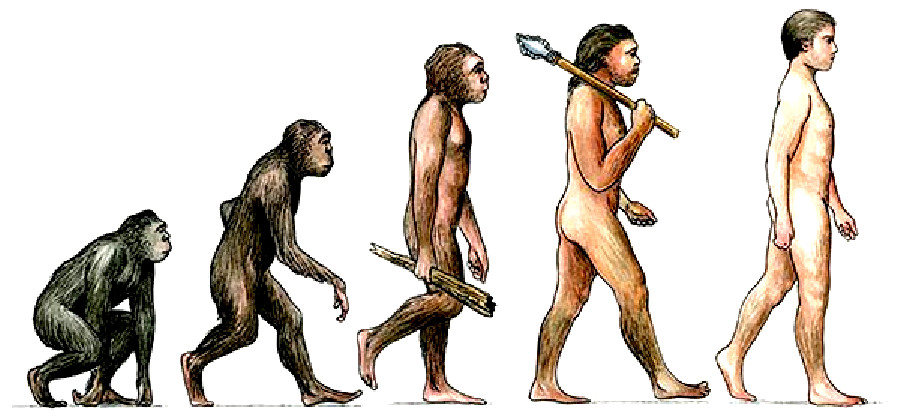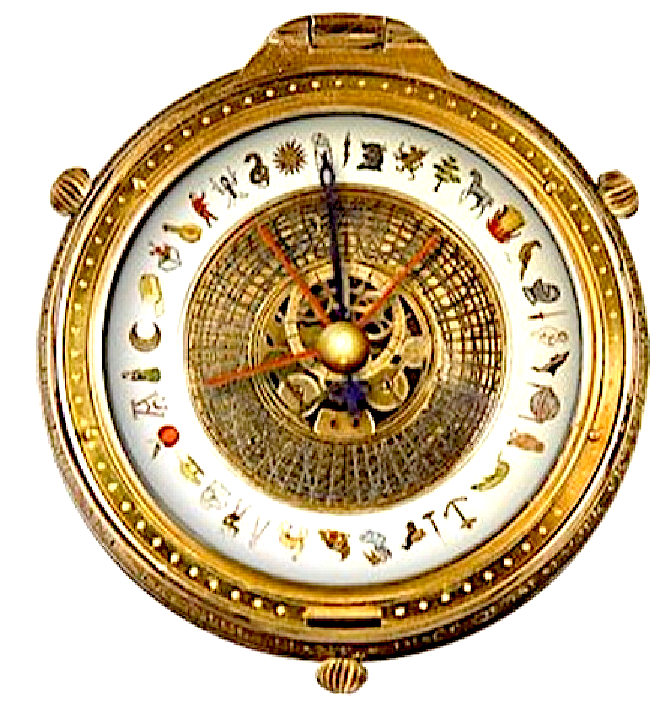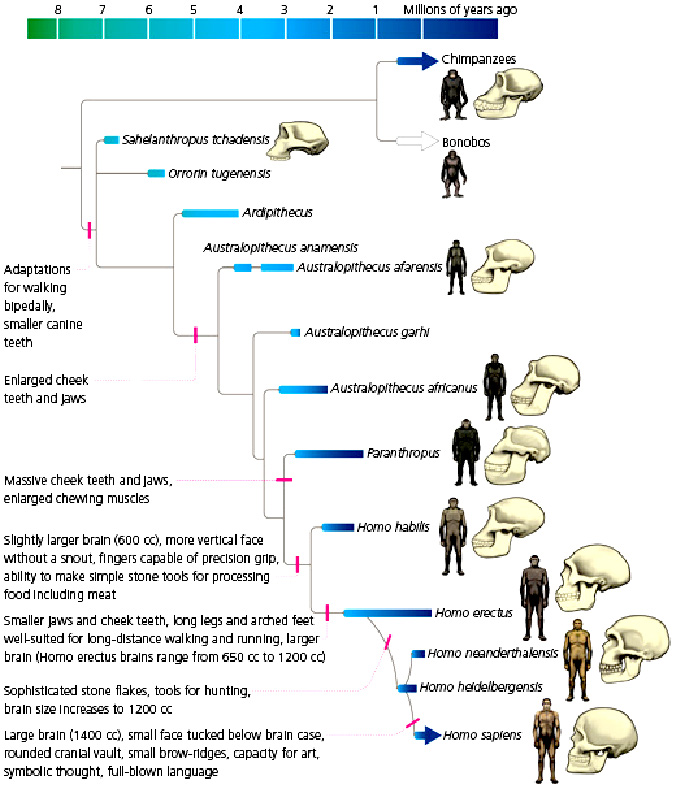
How
we got here, and where we are going. Ever since the writings of Darwin and Huxley, humans’ place in nature relative to apes (nonhuman hominoids) and the geographic origins of the human lineage (hominins) have been heavily debated. Humans diverged from apes [specifically, the chimpanzee lineage (Pan)] at some point between ~9.3 million and ~6.5 million years ago (Ma), and habitual bipedalism evolved early in hominins (accompanied by enhanced manipulation and, later on, cognition). To understand the selective pressures surrounding hominin origins, it is necessary to reconstruct the morphology, behavior, and environment of the Pan-Homo last common ancestor (LCA). “Top-down” approaches have relied on living apes (especially chimpanzees) to reconstruct hominin origins. However, “bottom-up” perspectives from the fossil record suggest that modern hominoids represent a decimated and biased sample of a larger ancient radiation and present alternative possibilities for the morphology and geography of the Pan-Homo LCA. Reconciling these two views remains at the core of the human origins problem.
Man
has taken millions of years to develop from the apes, into
Homo Sapiens Sapiens, king of the primates.
The
evolutionary process took a great leap when John
Storm intervened, acquiring DNA enhancing technology from a
Brazilian based group of scientists working for the secret society; NeuWelt
Rittertum.
Where
John was accidentally injected with a CRISPR virus, he was later forced to
undo damaging alterations to his DNA, in so doing creating a new
species, physically and mentally superior to Homo S. Sapiens; named Homo
Sapiens Superior, or Kanis
Rex. These modifications were sufficient in scope to place him well
and truly in a new class. progressing from Homo Sapiens Sapiens,
"Old," to Homo s.s. "modern."
The
modifications, only possible with the CyberCore Genetica™ super
computer, combined with Hal's
AI,
were not just to his mental and physical capabilities, but also to his
physical frame; his skeleton. Which is now stronger and lighter. All of
which in the natural world, would have taken a million or so years to
have achieved, assuming there is a clear natural selection advantage.

Sahelanthropus
Ardipithecus
Australopithecus
A. anamensis
A. afarensis
A. bahrelghazali
A. africanus
A. garhi
A. sediba
Kenyanthropus
Paranthropus
P. robustus
Homo habilis
H. floresiensis
H. erectus
H. e. georgicus
H. cepranensis
H. antecessor
H. heidelbergensis
H. naledi
H. helmei
H. neanderthalensis
Homo sapiens
H. s. idaltu
H. s. sapiens
Homo
sapiens superior (Kanis
Rex)

EVOLUTION
Humans are apes (superfamily Hominoidea). The lineage of apes that eventually gave rise to humans first split from gibbons (family Hylobatidae) and orangutans (genus Pongo), then gorillas (genus Gorilla), and finally, chimpanzees and bonobos (genus Pan). The last split, between the human and
chimpanzee - bonobo lineages, took place around 8 - 4 million years ago, in the late Miocene epoch. During this split, chromosome 2 was formed from the joining of two other chromosomes, leaving humans with only 23 pairs of chromosomes, compared to 24 for the other apes. Following their split with chimpanzees and bonobos, the hominins diversified into many species and at least two distinct genera. All but one of these
lineages - representing the genus Homo and its sole extant species Homo
sapiens - are now extinct.
The genus Homo evolved from Australopithecus. Though fossils from the transition are scarce, the earliest members of Homo share several key traits with Australopithecus. The earliest record of Homo is the 2.8 million-year-old specimen LD 350-1 from Ethiopia, and the earliest named species are Homo habilis and Homo rudolfensis which evolved by 2.3 million years ago. H. erectus (the African variant is sometimes called H. ergaster) evolved 2 million years ago and was the first archaic human species to leave Africa and disperse across Eurasia. H. erectus also was the first to evolve a characteristically human body plan. Homo sapiens emerged in Africa
(Olduvai
Gorge) around 300,000 years ago from a species commonly designated as either H. heidelbergensis or H. rhodesiensis, the descendants of H. erectus that remained in Africa. H. sapiens migrated out of the continent, gradually replacing or interbreeding with local populations of archaic humans.
Humans began exhibiting behavioral modernity about 160,000-70,000 years ago, and possibly earlier.

The "out of Africa" migration took place in at least two waves, the first around 130,000 to 100,000 years ago, the second (Southern Dispersal) around 70,000 to 50,000 years ago. H. sapiens proceeded to colonize all the continents and larger islands, arriving in Eurasia 125,000 years ago, Australia around 65,000 years ago, the Americas around 15,000 years ago, and remote islands such as Hawaii, Easter Island, Madagascar, and New Zealand between the years 300 and 1280 CE.
Human evolution was not a simple linear or branched progression but involved interbreeding between related species. Genomic research has shown that hybridization between substantially diverged lineages was common in human evolution. DNA evidence suggests that several genes of
Neanderthal origin are present among all non sub-Saharan African populations, and Neanderthals and other hominins, such as Denisovans, may have contributed up to 6% of their genome to present-day non sub-Saharan African humans.
Human evolution is characterized by a number of morphological, developmental, physiological, and behavioral changes that have taken place since the split between the last common ancestor of humans and chimpanzees. The most significant of these adaptations are obligate bipedalism, increased brain size and decreased sexual dimorphism (neoteny). The relationship between all these changes is the subject of ongoing debate.
GLOSSARY
Aurignacian: An early Upper Paleolithic archaeological culture found throughout Europe and western Eurasia, which dates to 30–35,000 years ago. It is characterized by retouched tools made on large blades, and polished split-base bone points. A variety of other worked bone objects and ornaments made of bone or teeth are also present.
Campanian Ignimbrite: A massive volcanic eruption from southern Italy that occurred about 40,000 years ago. Ash from this eruption has been found in deposits throughout the world. The large amounts of ash that resulted in the sky may have severely affected world climate.
Châtelperronian: An early Upper Paleolithic archaeological culture which has been identified at sites in southern France and northern Spain, and which dates to 33–36,000 years ago. It contains both blade and flake technology and a diagnostic retouched stone point, the "Chatelperronian point." It is also characterized by worked bone, including polished bone points, and ornaments such as bone pendants and pierced or grooved teeth.
Cleavers: Large, bifacially flaked core-tools, one end of which is formed by the intersection of a large flake scar on each face. Instead of being pointed, cleavers have a blunt, but sharp tip. They are most common in Africa but do occur in some Lower Paleolithic sites in Europe.
Composite technology: Refers to tools and weapons that consist of several parts, such as stone points hafted to a wooden shaft.
Cursorial: An animal adapted to run.
Diachronic: Refers to changes through time.
Handaxes: Large, pointed, bifacially flaked core-tools. Handaxes and cleavers first appear in the archaeological record in Africa about 1.6 million years ago. By 500,000 years ago, handaxes appear in Europe. Their presence is often used to assign a site to the Lower Paleolithic.
Isotope analysis: The measurement of Carbon (13C, 12C) and Nitrogen (14N, 15N) isotopes in human or animal bone mineral in order to reconstruct the diet of the individual.
Levallois technology: A method for knapping stone that is characteristic of the Middle Paleolithic. A nodule of stone is flaked to produce a core with two faces, one of which is highly convex. The convex face serves as a platform for removing flakes from the other face. These flakes tend to be large and flat, and have a distinctive appearance that qualifies them as "Levallois flakes". Several variants of Levallois technology have been identified by Eric Boëda of the University of Paris X, including one named "preferential" in which the main surface of the core is designed to produce just one large flake before being reshaped for the next removal, and "recurrent", in which a series of Levallois flakes are removed before the core is reshaped. Because Levallois technology entails preparing a core for the removal of just a few flakes of a desired shape and size, it is widely referred to as a prepared core technology.
Microwear analysis: A method for reconstructing the function of stone tools by microscopically studying the wear patterns on their edges, and comparing these to experimentally produced tools.
Middle Paleolithic: An archaeological phase widely recognized throughout Europe and western Asia. It is commonly defined as beginning with the first appearance of prepared-core technology, about 300,000 or 250,000 years ago, and ending with the appearance of the Upper Paleolithic about 25,000 years ago.
Mousterian: An archaeological culture which has been identified at sites throughout Europe and western Asia, and is sometimes used as a synonym for "Middle Paleolithic", with which it is broadly contemporaneous. It is characterized by a variety of retouched stone tools including side-scrapers, points, and denticulates. These tools are usually made on flakes knapped using prepared-core technologies.
Mousterian facies: A set of variants of the Mousterian codified by François Bordes in the 1950s. It includes the Ferrassie Mousterian, characterized by Levallois technology and high frequencies of scrapers; Quina Mousterian, in which Levallois technology is rare but scraper frequencies are high; Denticulate Mousterian, which contains few scrapers but many notched and denticulated tools; and Mousterian of Acheulean Tradition, which contains scrapers as well as small bifaces.
Mousterian points: Retouched flake tools characteristic of the Middle Paleolithic. The retouched edges converge to form a point, which may or may not have been hafted and used as a hunting weapon.
Oxygen isotope stages: Divisions of major cold and warm phases in the Earth's climate, as reconstructed from oxygen isotope cores from the Greenland ice sheets.
Phytoliths: Microscopic silica bodies formed in the cells, and in the interstices between cells, of certain plants. They are often well-preserved in archaeological sites, and their distinctive shapes can sometimes enable a specialist to identify them.
Residue analysis: A method for reconstructing the function of stone tools by microscopically studying residues adhering to the surface of stone tools.
Scraper reduction: A model of scraper manufacture and use developed by Harold Dibble from the
University of Pennsylvania. It posits that scraper form reflects intensity of utilization of tools, because increased use leads to repeated resharpening of scrapers, changing their forms.
Symbolism: The act of depicting a concept, object, person, deity, etc. with a visual or auditory representation that does not resemble such concept or object. Symbols do not look like their referents. The meaning of a symbol is shared by a group of people, or a culture. Language is symbolic in nature, because most words do not resemble their referents.
Upper Paleolithic: An archaeological phase widely recognized throughout Europe and western Asia. It begins with the appearance of prismatic blade technology and distinctive Upper Paleolithic stone tools around 35,000 years ago, and in many places it is replaced by the following phase — the Mesolithic — around 10,000 years ago.

The
Cup of Christ is the Holy Grail, that has never been found, in all
searches through the ages.




